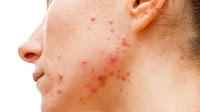July 19, 2016
Acne in Women
 |
| Mild Acne |
 |
| Severe Acne |
 |
| Moderate Acne |
The Facts
Acne is a chronic inflammatory skin condition that can occur on the face, neck, chest, back, shoulders and upper arms. This condition is common and affects more than 50 percent of women between the ages of 20-29 and more than 25 percent of women between the ages of 40-49.
Women can get acne for a number of reasons that includes overactive oil gland, heredity, menstruation, hormones and emotional stress. High glycemic foods like bread, rice, pasta and sweets have all been linked to acne. Eating a healthy, balanced diet can help prevent breakouts.
Acne Treatment
- One of the most important things that you can do to treat acne is to gently wash the affected area twice a day with a mild non-drying soap
- Shampoo your hair often
- To prevent scars, do not pop, scrub or pick acne
- For moderate to severe acne, oral antibiotics may be needed. A visit to the dermatologist would be required for this treatment.
- For mild acne, topical treatment should be sufficient.
- Birth control containing estrogen may also help clear acne in women if other treatments won’t work. Patients must visit a dermatologist and be carefully screened before using any hormonal therapy for acne because there are numerous factors that increase the risks in using this medication. Your dermatologist will discuss the risks of this treatment with you.
Scarring from severe acne can have significant psychological side effects such as permanent poor self esteem, anxiety and depression. Safe and effective treatment options for scarring include laser resurfacing, dermabrasion, chemical peels and skin fillers. If this is a treatment option that you’re interested in, it’s important to consult with your dermatologist to determine an individual treatment plan for the most successful results.
For more information about acne in women please visit aad.org






